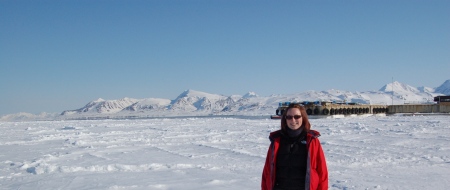
Ny-Alesund from a newbie’s point-of-view!
May 8, 2009Well, after 2 days of travelling I arrived in Ny-Alesund yesterday, via Oslo and Longyearbyen. I’ve been looking forward to arriving here for a long time now, especially after reading the blog for the last couple of weeks – so as you can imagine I was very excited to finally get here! (So excited that I tried to run before I could walk, and before I’d got my ice-legs working, as you can see in the video!)
When you’ve built something up in your head for so long, it’s a bit surreal to experience it at last, so I’m struggling to describe what it feels like to be up here. The most striking thing to a new-person-on-base is how much like a normal town it is. Apart from the precautions you have to take, like dressing for the cold and not straying beyond the boundaries in case of polar bears, it feels pretty much like walking around any other base or university, and sometimes sitting at my desk I have to catch myself, look out of the window at the gleaming white mountains over the fjord, and think “yeah – I really am in the Arctic!”
The other really striking thing is the 24-hour sunlight. It gives the day a weirdly timeless quality, so hours can pass and it feels like you’ve just been sitting there for 20 minutes. I think my favourite thing to photograph at the moment is the midnight sun peeping over the edge of a hut or mountain – although the sun doesn’t set, the light changes at nighttime and gives the sky a beautiful golden hue. Below is a photograph I took in Longyearbyen, of people walking around the town at 2 o’clock in the morning.

Longyearbyen at 2am. Photo: Bonnie Laverock
I’ll leave you with a picture of me standing on the sea ice in front of our marine laboratory – the ice breaker has cleared the fjord up to the pier in the background, but here it’s still thick enough to stand on, and if you’re really quiet you can hear it creaking as it moves slightly beneath you …

Standing on the sea ice. Photo: Bonnie Laverock




So based on your 2 trips so far this year, which place is more beautiful – Ny-Alesund or Sheffield?
There are many similarities between the two.
I just sat through that entire video expecting that I would get to see Bonnie running and falling on her bottom. Very dispointing. I did however catch an interesting exchange of words behind the camera… HF “Bonnie better be on this plane”, HW “or David Bellamy”…? Or perhpas I misheard it?
Looks like that was an amazing field trip!!